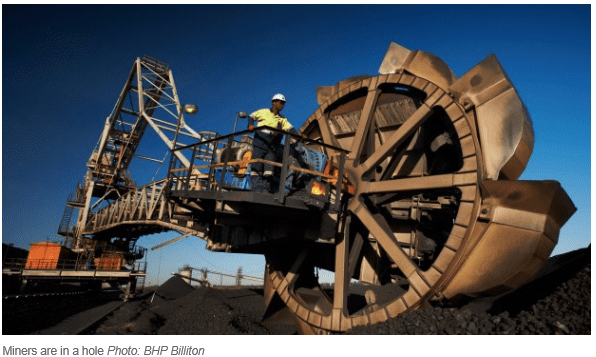
The unprecedented dive in the value of shares in miner and commodities trader Glencore is unlikely to push discerning investors to dump resources stocks from their portfolio, despite a punishing day on the Australian share market.
Shares in Glencore dropped almost 30 per cent in London on Monday after the release of an analyst note by British investment bank Investec, which said its investors’ holdings could be rendered virtually worthless if commodity prices stayed at their current levels.
The S&P/ASX 200 tumbled with the miner yesterday, falling to less than 5000 for the second time in a week. At the close the benchmark had lost more than $50 billion and was sitting at 4918.4.
Australia’s big miners suffered significant falls, with BHP Billiton shares dropping 6.7 per cent to a seven-year low – ignoring the effect of the South32 demerger – to $21.61, while Rio Tinto’s fell 4.6 per cent to a two-year low of $46.52.
Despite the carnage, long-term investors were expected to differentiate between Glencore’s debt woes and the structural issues affecting the sector, fund managers and analysts said.
Kate Howitt, portfolio manager of Fidelity’s Australian Opportunities Fund, said Glencore’s “one-directional” leverage to the commodity cycle upswing was always doomed in a down market like the current one and its share plunge gave her more conviction in her strategy of targeting low-cost producers like BHP.
“Glencore and BHP and Rio have taken different strategies in the space and are now having different outcomes. Yes, BHP and Rio are down 5 or 6 per cent but there’s no question about their through-cycle viability,” she told The Australian Financial Review.
One of its top holdings
Fidelity’s Australian Opportunities Fund has BHP as one of its top holdings and holds Rio as an underweight.
But Ms Howitt said the big miners’ losses were a small price to pay, relative to what happened to Glencore.
“We quite like the fact that you can own assets that have one of the best cost positions in their space and on days like today they’ll be dragged down with the rest of the sector, but at least you’re not worrying about whether the equity value is going to be there in a year or two,” she said.
Ms Howitt also singled out oil and gas exploration company Oil Search as a business with favourable margins in the current market.
Romano Sala Tenna, a portfolio manager at Katana Asset Management, agreed with Ms Howitt that it was “not surprising” Glencore was sold off and that investors were recognising its relative risk compared to other miners.
“They have taken on more risk in terms of debt and in terms of commodity risk,” he said. “Glencore has been the one who’s written off more than anyone else over the last 10 years and they have geared up.”
He said from a resources sector point of view the downturn would be transient and he questioned whether it was at the point of a turnaround.
Signs of capitulation
“There are signs there could be a capitulation but we still think it’s a little too early,” he said.
Michael Evans, co-founder of Quest Asset Management, said while it was “hard to be optimistic about resource plays”, he held BHP on the off-chance there was a recovery in demand for commodities in future.
Despite the slump in BHP’s share price, Gavin Wendt, a resources investment analyst at MineLife, said long-term investors would not rush to sell their BHP and Rio holdings if they had kept them until now.
On the contrary, he said, they could even increase their allocation to the mining titans.
“What’s happening now isn’t new. It’s been happening for a couple of years now and I think they’ll make the clear distinction between the financial health of a BHP or a Rio Tinto, which is paying a very strong yield, and … companies like Glencore, which hasn’t made the tough decisions,” he said.
Glencore was seen by investors as a market darling because of its entrepreneurial activities and its ability to withstand the first iron ore price drop, unlike BHP and Rio, Mr Wendt said.
However, now investors were turning their attention to the more fundamental financial indicators they had overlooked previously , like the debt against its assets of $US30 billion ($42.7 billion).
“Some of the weaknesses of Glencore, primarily the company’s debt levels, have been exposed. It’s now having to sure up its balance sheet, its debt levels are high, the income it’s generating has plunged and it has now embarked on a significant equity raising.”
The miner had left most options on the table in a bid to recover from its recent troubles, including cutting dividends, selling assets and raising cash, he said.
Glencore’s assets in Australia include coal, copper and zinc mines in Queensland and NSW, as well as a nickel project in Western Australia. It also has an operations in Europe, the Americas, Asia and Africa.
